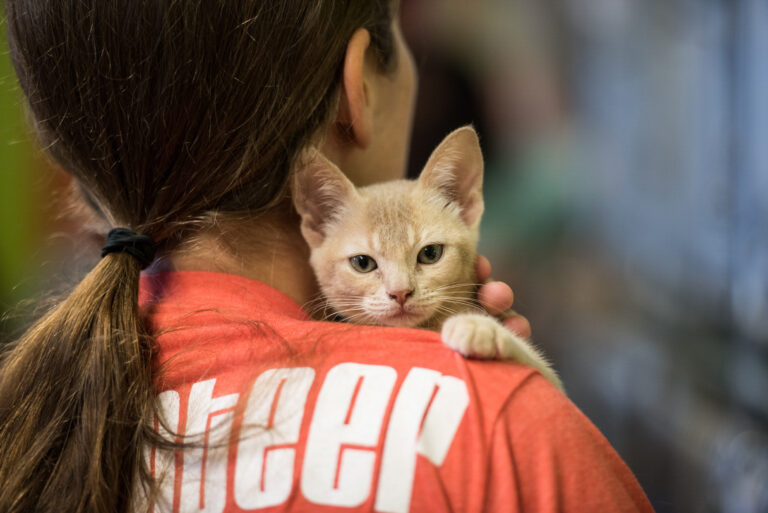Bringing home a rescue cat is an exciting and rewarding experience, but it requires preparation and patience. The first 30 days are crucial for helping your new feline companion adjust to their new environment, build trust, and feel safe in your home. Rescue cats often come from uncertain backgrounds, so giving them time and space to settle in will help them transition smoothly.
This guide will walk you through how to prepare your home, introduce your cat to their new environment, and establish a routine that fosters a strong bond.
Table of Contents
Before Bringing Your Rescue Cat Home
Set Up a Safe Space
A new environment can be overwhelming for a rescue cat, so it’s important to give them a quiet, secure space to start their adjustment.
- Choose a small room (such as a spare bedroom or bathroom) as their initial safe space.
- Provide food, water, a litter box, and a cozy hiding spot like a cat bed or box.
- Keep the room quiet and free from other pets or loud noises.
- Allow them to explore at their own pace without overwhelming them.
Gather Essential Supplies
Before your cat arrives, have the following supplies ready:
- Litter box and litter (use a familiar litter type to ease the transition).
- Food and water bowls (preferably stainless steel or ceramic).
- High-quality cat food (ask the shelter about their current diet to avoid digestive issues).
- Scratching post or pad to encourage proper scratching habits.
- Cat bed and blankets for comfort.
- Toys for stimulation (wand toys, small balls, or interactive toys).
- A carrier for safe transportation.
Cat-Proof Your Home
Cats are naturally curious, so take precautions to make your home safe:
- Secure loose wires and cords to prevent chewing.
- Remove toxic plants (such as lilies, poinsettias, or philodendrons).
- Store away household chemicals and medications.
- Keep small objects and fragile items out of reach.
- Ensure windows and balconies are securely closed.
The First 30 Days with Your Rescue Cat
The first month is about building trust and routine while allowing your cat to feel at ease in their new home.
Days 1-3: Allow Time to Adjust
Your cat may be nervous or hide for the first few days, which is completely normal.
- Let them explore their safe room at their own pace.
- Avoid forcing interactions—sit quietly in the room and let them come to you.
- Keep their routine consistent, feeding them at the same time each day.
- Speak in a calm, gentle voice to help them feel safe.
Some rescue cats may take longer to warm up, so patience is key.
Days 4-7: Gaining Trust
Once your cat starts to venture out of hiding, you can gradually introduce more interaction.
- Offer treats or wet food by hand to build positive associations.
- Engage in gentle play with wand toys to encourage confidence.
- Begin short, quiet petting sessions if your cat is comfortable.
- Keep a consistent feeding and litter box cleaning schedule to establish security.
If your cat seems comfortable, you can slowly introduce them to more parts of the home (one room at a time).
Week 2: Expanding Their Space
Once your cat is more confident, allow them to explore the rest of your home supervised.
- Open the door to their safe room and let them come out on their own.
- Provide hiding spots and vertical spaces (like cat trees or shelves) where they feel secure.
- If you have other pets, start a gradual introduction process (keeping them separate at first).
By this stage, many cats begin to show their personality, whether it’s playful, affectionate, or independent.
Week 3-4: Strengthening the Bond
By now, your cat should be comfortable with their surroundings. Focus on reinforcing trust:
- Spend quality time playing and interacting with them.
- Respect their personal space—some cats prefer quiet companionship over constant cuddles.
- Introduce basic training, such as using a scratching post or responding to their name.
- Watch for behavioral changes—a relaxed, playful demeanor means they’re feeling at home.
Some cats adjust quickly, while others take several months to fully settle in. Let them go at their own pace.
Introducing Your Cat to Other Pets
If you have other pets, a slow introduction process is crucial:
- Keep them separated for the first week to prevent stress.
- Swap scents by exchanging bedding or using a soft cloth to rub both pets.
- Allow supervised interactions with a barrier (like a baby gate or cracked door).
- Gradually allow face-to-face meetings, rewarding calm behavior.
- Let them adjust at their own pace—some cats take weeks or months to accept new companions.
Common Challenges and How to Handle Them
- Hiding – Normal for new cats; give them time and let them come out on their own.
- Not Eating – Try warming wet food or offering a familiar brand from the shelter.
- Litter Box Issues – Ensure a quiet, accessible location and clean it regularly.
- Excessive Meowing – May indicate stress; provide a routine and reassurance.
If behavioral concerns persist after the first month, consult a veterinarian or cat behaviorist for guidance.
In Conclusion

The first 30 days with your rescue cat set the foundation for a lifelong bond. By creating a safe, structured environment, being patient, and allowing them to adjust at their own pace, you help your new feline companion feel secure and loved.
Adopting a rescue cat is an incredibly rewarding experience. With time, trust, and love, your cat will blossom into a happy and affectionate member of your family.







